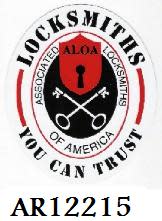Understanding your Commercial Locks
Call Northwestern Lock at (262) 542-6377 for more information!

-
DOOR HANDING
Some hardware requires handing. It is made to fit only one way the door swings, especially ADA compliant hardware. To provide some standard understanding of our industry, this chart shows the correct terminology, so if you are ordering a lock or parts and the door needs to be handed - here is the correct way to determine which way it swings. Stand outside and look at the door.
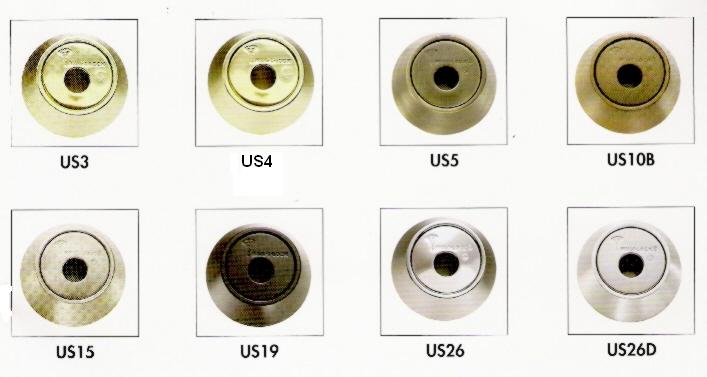
-
FINISHES
- US 3 Bright Brass
- US 4 Satin or Dull Brass
- US 5 Antique Brass
- US 10B Oil Rubbed Bronze
- US 15 Satin Nickel or Pewter
- US 19 or "079" Black or Dark Brown
- US 26 Bright Chrome also US32 Stainless
- US 26D Satin Chrome
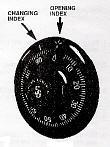
-
HOW TO DIAL A SAFE LOCK
We get many calls from clients who have the correct, safe combination but just cannot get the thing to open. To save you a call, here is the method to open a safe lock which would be set to say a combination like "50 - 25 - 50" substitute your own numbers for these.
- See diagram right for the position of the opening index.
- Turn the dial to the LEFT, stopping when "50" is aligned with the opening index for the FOURTH time.
- Turn the dial to the RIGHT, stopping when "25" is aligned with the opening index for the THIRD time.
- Turn the dial to the LEFT, stopping when the "50" is aligned with the opening index for the SECOND time.
- Turn dial SLOWLY to the RIGHT until the bolt retracts and the dial stops turning. Do not force beyond this point.
- Your safe should be open now.

-
HOW TO CHANGE A SIMPLEX 1000 - 3000 - 5000 - 7000 - 8000 SERIES MECHANICAL COMBINATION ENTRY LOCK
From our search strings, we know that you are looking for information on how to change these locks. I am reluctant to openly publish this because if you screw up the job, your lock will need to be serviced by an authorized Simplex dealer to get it working again. You have to follow these instructions EXACTLY, or this won't work. See the diagram right for the steps which need explaining.
For the 1000 series or 3000 series, you first need a "DF-59" key to extract the lock on the inside of the door. Along with the "installation tool," see the diagram for what it looks like. These should have been left with you when the lock was installed. IF you do not have either item - STOP - you cannot change the combination on a lock. Call for service.
If you have both, then you are ready to proceed. The first step is the lock MUST be installed on the door. Do not attempt to remove the lock - or take it apart. There are parts inside that need to be "timed," and if you get those out of time - the lock will not work. Second, the door must be open.
- See diagrams right for each stage of the operation.
- To change the 1000 / 3000 lock ... The steps are shown in diagram 13 from the Kaba book.
- Insert the DF-59 control key (B) into the combination change plug assembly (C) and remove it, turning counterclockwise. Remove the plug to gain access to the combination change sleeve. [ The "A" in diagram 13-1 is the passage knob or lock, it does not apply to this instruction ]
- Turn the outside lever or knob once in the normal operating direction. Release it. (13-2)
- Enter the existing combination.
- Insert the installation tool as shown right. This is to engage the combination change sleeve (A)(13-3) -- GENTLY turn the wrench clockwise to the internal stop. About 45 degrees or so. A slight click should be felt as well as heard. Then turn the wrench back-counter clockwise to the start position. (13-4)
- Turn the outside lever or knob ONCE to the stop position, and release again. (13-2)
- Choose your new combination. WRITE it down, then enter the combination - depress the buttons carefully and completely. A slight click should be felt as each button or button set is pressed. Remember - you can use MORE than one button at each "combination step" -- i.e., press 3 for the first number - then (25) TOGETHER for the second - be sure you press BOTH simultaneously then 1 for the last number. This would give you a combination of 3 -(25)- 1. Remember you can USE EACH NUMBER ONLY ONCE in a Simplex Mechanical Lock
- Turn the outside lever or knob ONCE in the OPENING DIRECTION. (13-2) This should lock in the combination. Try it again with your new combination. It should work. TRY your old combination. It should not... TRY it without entering ANY combination. It should NOT work. IF this does not work EXACTLY as it should, STOP - Call for service.
- Reinstall the combination change plug, and remove the DF-59 key. The job is done.
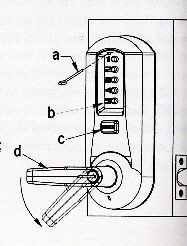
-
CHANGING THE SIMPLEX 5000 SERIES MECHANICAL LOCK
This lock changes much like the 1000/3000 series with a slightly different method. See the diagram right for the 5000 series, and again follow the steps EXACTLY, or the lock will not work. The lock MUST be installed on the door.
- See diagram right for the callouts.
- Rotate the outside lever (D) ONCE to stop position and release.
- Press the existing combination on the pad at (B) followed by the ENTER button (C) and release. DO NOT TURN THE LEVER !!
- Insert the lever release tool, which should have been left with you (A) through the hole in the upper left of the number pad. Gently lift up the loop end of the tool to depress the interior code change button until you hear a slight click. Remove the tool and DO NOT PRESS ANY BUTTONS.
- This next step is essential. Rotate lever (D) ONCE and only ONCE to clear the old combination. The latch will retract. Release the lever.
- Enter your new combination as in the 1000 / 3000 series on the combination pad (B) FOLLOWED BY THE ENTER button, then release.
- Rotate the lever (D) to verify and lock in your new combination. Make sure you press and release the "ENTER" button each time you try the combination. The latch will not retract until the "ENTER" button is depressed and released.
- Try your new combination. It should now work. Try your old one. It should NOT work. Try it without ANY combination. It should NOT work. IF it does not work as set out here, call for service.
-
CHANGING THE 6000 / 7000 SERIES SIMPLEX LOCKS
The 7000 series, along with the 6000 series of light-duty deadbolts and night latch locks, work the same way, except -- the access to the combination chamber is through that "cross" screwed on the inside of the door. Do not remove it or any other part of the lock while changing the lock.
- With the door open, turn the operating knob to the left - counterclockwise to the stop and release.
- Enter the existing combination. Make sure you press and release each button fully.
- With a Phillips screwdriver, turn the combination change sleeve - The ( + ) in the center of the top of the inside assembly - about 45 degrees to the right. DO not force. A slight click will be heard and felt. Turn the ( + ) back to the start position, where it usually sits.
- Turn the operating knob to the left - counterclockwise to the stop position to clear the old combination.
- Enter your new combination as in the 1000 / 3000 series. Be sure you depress each button until you hear a slight click. Make sure you write down your new combination.
- Turn the operating knob to the right - clockwise to the stop position. This will lock in your new combination. Then release the knob.
- This should complete the job. Try your new combination. It should work. Try the old combination. It should NOT work. Try it with no combination. It should NOT work. IF any of this is not as set out, call for service.
These are heavy-duty locks and will work for many years without problems. Changing combinations is an exact process that needs to be followed to the letter due to the mechanical aspect of the lock.
The Simplex E-Plex 3000, E-Plex 5000 series and all other electronic locks are not serviceable for the end-user unless you have been shown how to do so and have the Master Codes and been trained by the installing company to change out your combinations.
The Simplex 8000 Mortise lock is a very fussy timed lock - do not attempt to change or work on this complex lock, for if you drop ANYTHING out of time, you may damage the internal parts.
Northwestern is not responsible for your work if you try to do anything which we show or describe. These methods are straight out of the KABA SIMPLEX installation books. These should have been left with you when the locks were originally installed, and you should have been shown how to do so at that time. These instructions are only for those who do not have the original materials and have the working knowledge to do so correctly. We assume no liability for your independent actions, nor do we warrant anything you do to your own hardware. They are presented here for the public's information ONLY.
-
MASTER KEYING
This is a very misunderstood process. First, there is NO key out there someplace which can open any lock. This is an urban myth that arose out of the old "skeleton key era." Today with modern six-pin locks, there is nothing that will open a lock except the correct key.
In fact, any key can end up being a master key, which is why this job needs to be done only by a trained locksmith or security professional. There are kits available for the end-user to try to accomplish this, but in the end, you will end up making a mess of it. WHY?
Because the art of Masterkeying is the controlled destruction of security, when you add "master pins" to a lock, you create more than the intended number of keys that could fit the lock in theory. This makes "phantom keys" which are not in your system and could unintendedly open your locks. Along with this, you need keys that are cut to factory specifications which would allow them to work without binding, or "clicks," - which means they match the specs of the cylinder being keyed.
Keys for master keyed systems should only be produced on "key generators," which make originals only, not duplicates. If your locksmith does not have a key machine like a Framon 2 or HPC 1200 or the equivalent, go someplace else and look for real security professional. Depth keys will work, but you are getting keys that are, in fact, "duplicates," not true "originals." This will cause problems down the road if they are not true originals.
Random or "shoebox" keying really makes for a messy job. The system has to be planned out so that the number of phantom keys is reduced to the absolute minimum, and the correct cuts or bittings are set on each key blank. Filing the cylinder to make the keys work will only make the problem of phantom keys worse and really reduce your security.
Spend the time to work with your security professional to get what you want exactly out of your master key system, and it will be there. High-security locks will reduce the problem of phantom keys almost totally. Invest in your security by having it done by a true Security Professional. Most belong to professional security organizations, like the Associated Locksmiths of America. Ask for their credentials. This is not foolproof - but it is a good step to ensure yourself that the people doing the job have the training and experience to do it right.
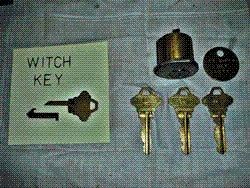
-
WITCH KEYS AND ONE WAY CYLINDERS
Here are two things which you can't buy from anywhere. They provide answers to problems and are made ONLY by a professional locksmith in their own shop.
On the left is a "witch key" or "lockout key." If you need to lockout a tenant or have some other situation where there are keys outstanding, and you want to lock out people - this is your answer.
Unlike keys of this type which can be had over the internet, this one doesn't have the little "tail" which sticks out. A tail sticking out invites the problem to try to use pliers to pull the keys out and breaks them off. This now is a major problem, to remove the broken part from the lock. A properly made lockout key does not have the tail to grab. It sits flush in the cylinder, and it has a little "dog," much like a mortise and tenon to pull the insert out.
With our witch keys/lockout keys, one inserts the lower portion into the lock, and it has a small stop to keep it from going deeper. Then the problem can't insert their key into the lock. TO remove this insert, one slides the top portion in, lifts up gently, then sets it down easy, gets the retractor to engage, and then removes the insert. An experienced landlord can do this in an instant.
The other interesting item in this photo is a "One Way Key" or B B Binks Cylinder. These are not available to the public and need to be made to order. If you look, there are three keys shown. The middle key will turn both ways. The key to the right only turns to the right. The key to the left only turns to the left. Why is this important?
If you own a business, do not lock up for the night, and need to leave a key for someone else to lock up - you don't want them coming back later and robbing you. SO you give them a key which ONLY turns in the direction of throwing the deadbolt / locking the door. Your key, of course, will lock and unlock the lock. This lock can also be master keyed, so your key will work all locks in the building, and the front door/entrance key will only lock up. Of course, you can also have one which only unlocks the door -- thereby showing who may have robbed you overnight.
Both of these items are usually made only by a Master Locksmith, who knows how they should work. Call us if you need one. These are made to order on request only.
We're only a phone call away! Call (262) 542-6377 and let us know how we can help.
BROWSE OUR WEBSITE
CONTACT INFORMATION
Phone:
(262) 542-6377
Email:
nwlock@execpc.com
Address: 1407 JOSEPHINE ST Waukesha, Wisconsin 53186 United States






BUSINESS HOURS
- Mon - Fri
- -
- Sat - Sun
- Closed
